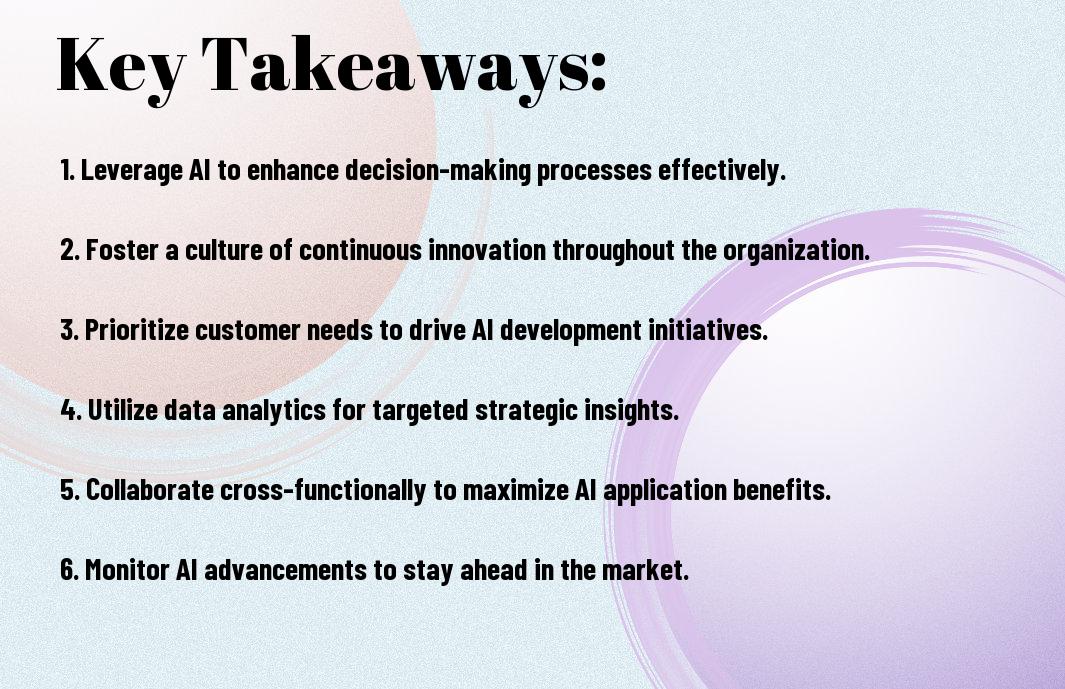As you navigate the complex landscape of modern business, you’re likely exploring ways to leverage technology for a competitive edge. You understand that integrating Artificial Intelligence (AI) can revolutionize your operations, enhance customer experiences, and drive growth. Your goal is to harness AI’s potential to innovate strategically, maximizing impact and propelling your business forward. You’re about to discover how to effectively integrate AI into your strategy, unlocking new opportunities and transforming your organization from within.

Key Takeaways:
- Embracing strategic innovation with AI integration can significantly enhance business operations, leading to increased efficiency and competitiveness in the market.
- AI-driven solutions can facilitate data-driven decision-making, enabling companies to make informed choices and drive growth through targeted strategies.
- Effective integration of AI requires a thorough understanding of the organization’s goals, challenges, and existing infrastructure to maximize its potential impact.
- Strategic innovation with AI involves continuous learning and adaptation, as the technology is constantly evolving, and businesses must stay up-to-date to remain relevant.
- By leveraging AI in strategic innovation, companies can unlock new opportunities, improve customer experiences, and create sustainable business models that drive long-term success.

The Tipping Point of AI in Business
Your business is on the cusp of a revolution with AI, and it’s time to harness its power for maximum impact. AI is transforming industries, and you must adapt to stay ahead.
When Technologies Reach Critical Mass
Whenever technologies converge, innovation accelerates, and AI is no exception. You’ll see exponential growth as AI adoption reaches critical mass, transforming your business landscape.
Identifying Your Organization’s AI Readiness
On the path to AI integration, you must assess your organization’s readiness. You need to evaluate your infrastructure, data, and talent to determine the best AI strategies for your business.
Organizations that successfully integrate AI typically have a clear understanding of their strengths, weaknesses, and goals. You will need to conduct a thorough analysis of your business to identify areas where AI can have the most significant impact, and then develop a tailored strategy to achieve your objectives, leveraging your unique strengths and addressing your weaknesses.
The Cognitive Revolution in Corporate Strategy
If you’re looking to integrate AI into your business, you’ll need to understand the cognitive revolution in corporate strategy, which is transforming the way you approach innovation and decision-making.
From Data Collection to Insight Generation
Alongside the rise of AI, you’re likely noticing a shift from mere data collection to insight generation, enabling you to make more informed decisions and drive business growth.
Decision-Making in the Age of Algorithms
Around the time you start leveraging AI, you’ll find that decision-making processes become more efficient, as algorithms help analyze vast amounts of data and provide actionable recommendations.
A key aspect of decision-making in the age of algorithms is that you will have access to predictive analytics, allowing you to anticipate market trends and make strategic decisions that drive your business forward, giving you a competitive edge in your industry, and enabling you to innovate and adapt to changing market conditions more effectively.
Small Changes, Massive Results
Many businesses have achieved significant gains by incorporating AI into their operations, and you can too by starting with small, strategic changes that add up to make a big impact on your bottom line.
Incremental AI Implementation Strategies
The key to successful AI integration lies in taking a gradual approach, allowing you to test and refine your strategies as you go, and make adjustments to maximize the benefits of AI for your business.
The Compounding Effect of Smart Automation
Smart investments in AI can lead to exponential growth, as automated processes free up resources for more strategic pursuits, enabling you to focus on high-value tasks that drive innovation and expansion in your organization.
Due to the nature of compounding effects, the benefits of smart automation can quickly multiply, allowing you to achieve greater efficiency, productivity, and profitability, and giving you a competitive edge in the market, as you continue to leverage AI to streamline and optimize your operations, you will be able to make more informed decisions and drive your business forward.
The Power of Context in AI Deployment
All successful AI deployments rely on understanding the context in which they will operate. To maximize impact, you must consider the environment and organizational climate.
Environmental Factors That Determine Success
To determine the success of AI deployment, you need to assess:
- market conditions
- customer needs
- competitive landscape
Assume that your analysis will help you make informed decisions about AI integration.
Creating the Right Organizational Climate
Creating a supportive organizational culture is imperative for AI adoption. You should foster collaboration, encourage experimentation, and provide necessary training to your employees.
Context is key when creating the right organizational climate for AI deployment. You will need to consider your company’s values, goals, and existing infrastructure to ensure a smooth integration of AI solutions, allowing you to leverage your strengths and address potential weaknesses, ultimately driving your business forward with AI-powered innovation.
Connecting Human Intuition with Machine Precision
To maximize business impact, you can leverage AI by learning How to Use AI for Strategy and Strategic Management to inform your decision-making process, enhancing your strategic innovation.
The New Division of Labor
AFTER you integrate AI into your workflow, you’ll notice a shift in tasks, freeing you to focus on high-level creative problem-solving and strategic thinking.
Cultivating Complementary Intelligence
ONE key aspect of strategic innovation is developing a symbiotic relationship between human intuition and machine precision, allowing you to make more informed decisions.
But as you cultivate complementary intelligence, you’ll find that your ability to analyze complex data and identify patterns improves, enabling you to drive business growth and stay ahead of the competition, and you will be able to make the most of your strategic innovation efforts by combining the strengths of both human and machine intelligence.
The Stickiness Factor of AI Solutions
For your AI solutions to have a lasting impact, you need to focus on creating experiences that keep users engaged and invested in the technology. This involves understanding your target audience, identifying their pain points, and developing solutions that address these challenges in a meaningful way.
Creating Memorable and Indispensable AI Tools
About the development process, you should prioritize simplicity, intuitiveness, and user experience, as these factors will determine how often your AI tools are used and how much value they bring to your organization. You can achieve this by involving your users in the design process and gathering feedback to inform your development decisions.
Designing for Adoption and Engagement
Against the backdrop of rapid technological advancements, you must design your AI solutions with adoption and engagement in mind, taking into account the needs and preferences of your users, as well as the overall business goals and objectives. You should strive to create seamless and intuitive experiences that foster a sense of familiarity and comfort.
Considering the complexities of human behavior and the factors that influence adoption, you will need to develop a deep understanding of your users’ motivations, habits, and pain points to design AI solutions that meet their needs and expectations, and ultimately drive business success. You can achieve this by leveraging data analytics, user feedback, and testing to inform your design decisions and optimize your AI solutions for maximum impact.
Summing up
The integration of AI in your business strategy can significantly enhance your innovation capabilities, allowing you to make informed decisions and drive growth. By leveraging AI, you can unlock new opportunities, optimize operations, and gain a competitive edge. As you commence on this journey, you will be able to harness the full potential of AI to maximize your business impact and achieve your goals, ultimately transforming your organization into a more agile and innovative entity.
FAQ
Q: What is Strategic Innovation and how can it be applied to integrate AI for maximum business impact?
A: Strategic Innovation refers to the process of creating new or improving existing business models, products, and services by leveraging innovative technologies like Artificial Intelligence (AI). To integrate AI for maximum business impact, organizations should identify areas where AI can drive significant value, such as process automation, predictive analytics, or customer experience enhancement. By aligning AI initiatives with business objectives and fostering a culture of innovation, companies can unlock new revenue streams, improve operational efficiency, and gain a competitive edge in the market.
Q: How can businesses ensure successful AI integration and maximize the potential of Strategic Innovation?
A: To ensure successful AI integration, businesses should start by defining clear goals and objectives, assessing their current data infrastructure, and developing a robust AI strategy. It is also crucial to invest in employee upskilling and reskilling to build a workforce capable of working effectively with AI technologies. Furthermore, organizations should prioritize data quality, ethics, and governance to mitigate potential risks associated with AI adoption. By taking a structured approach to AI integration, companies can minimize disruption, optimize benefits, and achieve sustainable business growth through Strategic Innovation.
Q: What role does leadership play in driving Strategic Innovation and AI adoption within an organization?
A: Leadership plays a vital role in driving Strategic Innovation and AI adoption by setting the vision, tone, and direction for the organization. Effective leaders must be willing to challenge traditional business models, encourage experimentation, and foster a culture of innovation. They should also prioritize investment in AI research and development, collaborate with external partners and stakeholders, and ensure that AI initiatives are aligned with overall business strategy. By providing clear guidance, support, and resources, leaders can empower their teams to explore new AI-driven opportunities, drive digital transformation, and achieve long-term success through Strategic Innovation.



